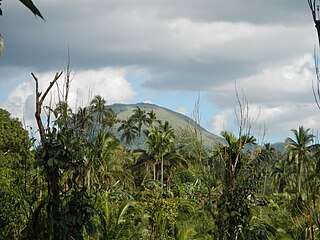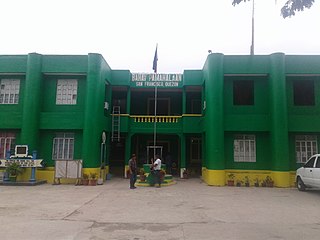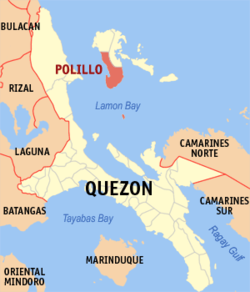
Padre Burgos, officially the Municipality of Padre Burgos, is a 4th class municipality in the province of Quezon, Philippines. According to the 2020 census, it has a population of 23,488 people.

Mabini, officially the Municipality of Mabini, is a 1st class municipality in the province of Batangas, Philippines. According to the 2020 census, it has a population of 50,858 people.

Real, officially the Municipality of Real, is a 1st class municipality in the province of Quezon, Philippines. According to the 2020 census, it has a population of 38,678 people.

Infanta, officially the Municipality of Infanta, is a 1st class municipality in the province of Quezon, Philippines. According to the 2020 census, it has a population of 76,186 people.

The Polillo Islands is a group of about 27 islands in the Philippine Sea lying about 25 km (16 mi) to the east of the Philippine island of Luzon. It is separated from Luzon Island by the Polillo Strait and forms the northern side of Lamon Bay. The islands are part of the province of Quezon in the Calabarzon region of the Philippines. The combined land area of all the islands is about 875 square kilometers making Polillo islands even larger than the island city-state of Singapore.

Famy, officially the Municipality of Famy, is a 5th class municipality in the province of Laguna, Philippines. According to the 2020 census, it has a population of 16,791 people, making it the least populated municipality in the province.

Kalayaan, officially the Municipality of Kalayaan, is a 3rd class municipality in the province of Laguna, Philippines. According to the 2020 census, it has a population of 24,755 people.

Balete, officially the Municipality of Balete, is a 5th class municipality in the province of Batangas, Philippines. According to the 2020 census, it has a population of 24,055 people. The people from Balete is called Baleteños.

Padre Garcia, officially the Municipality of Padre Garcia, is a 2nd class municipality in the province of Batangas, Philippines. According to the 2020 census, it has a population of 51,853 people.

Burdeos, officially the Municipality of Burdeos, is a 4th class municipality in the province of Quezon, Philippines. According to the 2020 census, it has a population of 24,644 people.

Dolores, officially the Municipality of Dolores, is a 4th class municipality in the province of Quezon, Philippines. According to the 2020 census, it has a population of 32,514 people.

General Nakar, officially the Municipality of General Nakar, is a 1st class municipality in the province of Quezon, Philippines. According to the 2020 census, it has a population of 34,225 people. It is the largest municipality in the province of Quezon in terms of land area, occupying 1,343.75 kilometers (834.97 mi). It is accessible by land from Metro Manila, passing through Marcos Highway.

Jomalig, officially the Municipality of Jomalig, is a 5th class municipality in the province of Quezon, Philippines. According to the 2020 census, it has a population of 7,667 people.

Panukulan, officially the Municipality of Panukulan, is a 4th class municipality in the province of Quezon, Philippines. According to the 2020 census, it has a population of 16,376 people. It is located in the northwestern part of the island of Polillo in the Polillo Islands.

Patnanungan, officially the Municipality of Patnanungan, is a 5th class municipality in the province of Quezon, Philippines. According to the 2020 census, it has a population of 15,052 people.

Perez, officially the Municipality of Perez, is a 5th class municipality in the province of Quezon, Philippines. According to the 2020 census, it has a population of 12,767 people.

Quezon, officially the Municipality of Quezon, is a 5th class municipality in the province of the same name. According to the 2020 census, it has a population of 15,886 people.

San Andres, officially the Municipality of San Andres, is a 4th class municipality in the province of Quezon, Philippines. According to the 2020 census, it has a population of 37,454 people.

San Francisco, officially the Municipality of San Francisco, is a 2nd class municipality in the province of Quezon, Philippines. According to the 2020 census, it has a population of 62,097 people.

San Narciso, officially the Municipality of San Narciso, is a 3rd class municipality in the province of Quezon, Philippines. According to the 2020 census, it has a population of 51,058 people.


























